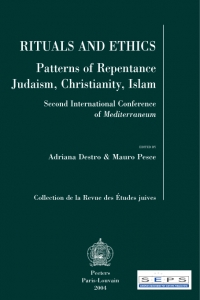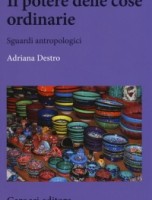Contents
Preface..........................................................................................vii
Confession in Ancient Egypt..............................................................1
Jan Assmann, Ruprecht-Karls-Universität Heidelberg
Ritual and Ethics in the Liturgical Structuring ofthe Book of Ezekiel..................................................................................................21
Marco Nobile, Pontificio Ateneo Antoniano, Rome
Repentance in Judaism.....................................................................33
Jacob Neusner, Bard College
Repentanceas Forgiveness, and the Role of Sacrifices in Jesus............51
Adriana Destro - Mauro Pesce, University of Bologna
TheStep beyond Judaism. What Became of “Metanoia” in Earliest Christianity among the Gentiles of Syria?.........................................99
Andreas Feldtkeller, Humboldt-Universität zu Berlin
TheSacrament of Repentance in the Orthodox Tradition: a Theological andCultural-Anthropological Approach........................................125
Petros Vassiliadis - Dimitris Passakos, AristotleUniversity of Thessaloniki
Censorship Virtues. Private Sickness and PublicHealing in the Penitential Regime of Ancient Christianity...........................................143
Giovanni Filoramo, University of Turin
Conditionsof Conversion in Early Islam.......................................163
YohananFriedmann, The Hebrew University of Jerusalem
Théoriesdu repentir chez les théologiens musulmans classiques........185
Mokdad ArfaMensia, Université des Lettres, des Arts et des Sciences Humaines de Tunis
L'acte expiatoireen Islam. “Al Kaffāra”.......................................215
Mongia ArfaMensia, Université des Lettres, des Arts et des Sciences Humaines de Tunis
The Baptism of Repentance: John theBaptist in the Mandaic Tradition. Rituals in a Religion between Judaism, Christianity, and Islam............................................................................................241
Gabriele Mayer, The Hebrew University of Jerusalem
Patterns of Repentance in Pico's Life and Thought.........................255
Pier Cesare Bori, University of Bologna
Preface
Thisvolume brings together essays presented to the Second International Conferenceof the Mediterraneum Centre.Founded in 1995 as a result of bilateral agreements between the University ofBologna and seven other European and Mediterranean universities, the Mediterraneum Centre is dedicated to theexploration of religions from the perspective of history, comparative religionand cultural anthropology. We publish the articles in the form they werepresented at the time the conference took place, in Bertinoro (Italy), 5-7November 1996. We would like to thank J. Neusner for having provided a home forthe volume in one of his series of publications, after the collapse of theScholars Press, and P. Morewedge, editorial director of Global Publications,for having accepted us. Our special thanks go to Dr. A. Damanti, who wasresponsible for the final preparation of the published text.
1. Thisbook seeks to understand the relation between rituality and ethics in Judaism,Christianity and Islam. A long theological and philosophical traditionconceives of ethics as necessarily in opposition to rituality. Within thisview, authentic moral behaviour is individual, born of the inner self, andrequires no external, social confirmation. By contrast, the ritual has to dowith what is external, favouring practical social conventions, without any realinner participation. It reduces morality to the obedience to a rule that doesnot spring from the self.
Inactual fact, a large number of studies of social and cultural anthropology,social history and social psychology have demonstrated that rituals arepowerful instruments of transformation, individual as well as collective. Innermoral transformations always seem to necessitate a social expression in orderto become real, and to re-establish previously violated human relationships.
Amongthe many possible ethical themes, the volume deals with one alone:“repentance”. There are no Judaic, Christian or Islamic systems in whichrepentance for transgressions committed is not considered necessary. Complexethical, psychological, ritual and juridical processes tend to provokerepentance and make it effective; without it, there can be no restoration of acorrect relationship between individual and individual, and between theindividual and God. Repentance has a very important systemic role in thesereligions.
Thefirst issue the book addresses is therefore to clarify how the variousreligious systems believe that repentance must imply a series of ritualprocesses, and how one must repent so that the forgiveness of sins becomeseffective. How does the cancellation of transgressions by God, and by peopleand society, occur? What individual and collective actions are required? Inother words, what patterns of repentance emerge from the various religioustraditions?
2.In our view, an anthropological scheme helps to clarify the relation betweenethics and ritual. In every social or religious system, in fact, when the rulesare broken and the customary relationships among individuals are no longerrespected, the orderly pattern of existence is upset. If an increasing numberof individuals ceases to respect a norm, confidence in it is socially weakened.The cancelling mechanisms or redressingtransgressions and guilt have first of all the double function ofdeclaring a specific kind of behaviour a transgressionas such, and implicitly, of obtaining from the whole of societyrecognition of the validity of the norms. Secondly, they allow the transgressorto be excluded from normal social relations. Finally, the transgressors can bereintegrated, but only after having recognised their guilt and redressed theirtransgression. The procedures for the elimination of guilt, therefore, areessential for readmission into a religious community. Transgressions are alwaysactions that introduce disorder into society, and for this reason, they requireprocedures that marginalia the transgressor and accommodate his reintegrationunder certain specific conditions. Repentance thus requires collective rituals,among which public confession, in certain Judaic and Christian systems, assumesparticular importance.
Clearly,this general scheme is subject to change according to its historical culturalsituation. The need to adapt the scheme to various situations becomes evidentin relation to a fundamental problem for this research project: the conceptualclarification concerning the nature of transgressionor sin. J. Assmann deals with theissue from a comparative perspective. He stresses the culturaldistinction between shame and guilt. "Shameis related to perception, to seeing and being seen. The notion of guilt,on the other hand, is related to memory, to remembering and being remembered.In a shame-culture, a transgression thatpasses unnoticed vanishes and does not constitute a problem. In a guilt-culturehowever, even unnoticed transgressionsstay on in the memory of the wrongdoer,form part of his person and constitute a problem that needs to be handled [...]Every guilt-culture is confronted with the problem of how to dispose ofaccumulated guilt and to develop techniques of guilt-disposal such as purification,confession, repentance, penitence, etc. If these cultural techniques orinstitutions succeed in purging accumulated guilt on a regular base, we mayspeak of purification cultures. If, however, guilt is accumulated in spite ofor beyond cultural efforts of purification, we are dealing with real oremphatic guilt cultures. Judaism and Christianity belong to the second type,ancient Egypt to the first one".[i]
3. Thecontributions of M. Nobile and J. Neusner focus on Judaism. M. Nobile arguesthat the function of the ritual in the Temple of Jerusalem, according to the Book of Ezekiel, is to guarantee thepresence of God in the Temple. In this type of Judaism, which emerged with the reform of Leviticus, as J. Neusner states: "sacrificeserves to remove the effects only of a sin committed inadvertently. Butsacrifice cannot atone for deliberate sin. Repentance can". Neusner's article is entirely dedicated to underliningthe extraordinary function of repentance in Rabbinical Judaism. "Repentancedefines a transaction of a wholly intangible character, in which theintentionality and attitude of a person transform the person through a rite ofself-generated enchantment. An inward religion, focusing attention upon theindividual's inner condition, Judaism in its doctrine of repentance reaches theapex of its insistence upon the proposition: ‘the All Merciful craves theheart’". The nature of repentance in Judaism shows itself most completelyin the classical formulation of the Babylonian Talmud: "The act ofrepentance commences with the sinner, but then compels divine response; theattitude of the penitent governs, the motive – love, fear – making thedifference. The power of repentance to win God over, even after recurring sin,forms the leading theme". But the basic point lies in the fact that thepower of repentance does not depend on carrying out an action, but in thedecision of the penitent to not repeat the sin: "no deed can be required;the penitent cannot have a more difficult task: not to do again what he hasdone before".
4. Theconception and praxis of repentance in Christianity are studied in fourcontributions. A. Destro-M. Pesce show that, for Jesus, theremission of sins by God is conceded quite independently from the ritual of Yom ha-kippurim. Those who repent theirsins invoke pardon directly from God, but they are obliged to pardon otherpeople. Jesus propounds a concatenation of forgivenessthat should radically renovate the society of Israelaccording to the ideal of the LeviticalJubilee. Jesus' position is thus very different fromthat of later Christianity, for which the forgiveness of sins by God is linkedto the salvific power of Christ’s death. A. Feldtkeller tries to reconstructthe position of the earliest non-Jewish followers of Jesus in Syria."Earliest Christianity among the gentiles had quite different options ofhow to shape metanoia in termsof rituals and ethics. Besides the far-reaching option of adapting non-Jews tothe overall system of Judaism, the change in direction required from gentilesto enter the Christian community could be mainly ritual, mainly ethical, oreven a call away from both ethical and ritual observance. So there is nogeneral answer to the question of what took the place of metanoia in earliest Christianity amongthe gentiles, but there is an open discussion, and there is still a long way togo until mainstream Christianity will make baptism the comprehensive rite offirst repentance in a Christian’s life and will develop the idea of a secondrepentance, which can also be acquired through a ritual process". P.Vassiliadis and D. Passakos consider the ritual processes of repentance tobring out a characteristic feature of Orthodoxy: the primacy of the community.This primacy is given value by the ritual aspect of repentance, which must spring from the community. The communitythus assumes a primary significance in relation to the doctrinal and juridicalaspects of Christianity. G. Filoramo examines the period from the mid-fourth tothe mid-fifth century. "Following the growing number of converted people,the Church was obliged to rethink the form of its initiation rite:baptism". Also penitence "that was the only means the church offeredof cancelling a mortal sin committed after baptism, underwent profound changes".In this period the principal aim of the ecclesiastical institution "wasnot the pastoral care of the individual sinner, but the preservation of the'health' of the social body ofbelievers". G. Filoramo concentrates therefore "on the publicaspect of penitence, that is, the way by which the community of believersparticipated in the therapeutic, moral and religious drama of the sinner who,having confessed his mortal sin, entered the penitential regime". One of the aspects elucidated by G. Filoramo, forexample, is the control exercised by the community in public repentance. This control has two functions:"the role of moral censorship that the community performed towards thesinner who was ashamed of publicly confessing his sins" and the role"of moral aid". The first function is made necessary by the newsituation, the second was the one previously exercised by the community"during the penitential regime".
5. Threestudies concentrate on Islamic themes. Y. Friedmann studies conversion to Islamfrom the point of view of Muslim tradition. This is one of the basic problemsin the passage from one religion to another. The paper is not concerned withconversion as a social or historical process, but "exclusively with thetraditional perceptions of the ways in which a non-Muslim can enter the Muslimcommunity". "While it is true that the pronouncement of the shahāda('there is no god except Allah and Muh9ammad is the Messenger of Allah') is an essential element in the processof conversion to Islam, a study of Muslim jurisprudence (fiqh), prophetic tradition (h[adīth) and Qu’ranic exegesis (tafsīr) will reveal that in manycircumstances it is not sufficient in itself".In some texts "a Muslim must not only affirm his faith verbally, but alsoparticipate in religious ritual and pay his share in financing the nascentMuslim state". "Thetraditions which imply that the mere utterance of the first shahāda is sufficient to ensure eternal salvation seemto support the notion that in Islam faith need not be supported by works",but "it certainly does not represent the mainstream of Muslimopinion". Jews and Christians who convert "must not only pronouncethe two shahādas, but also explicitly renounce their formerreligious affiliation". Finally, "in the literature of Muslim jurisprudence, there is some discussion ofthe question whether conversion to Islam may be effected not only verbally, but also by characteristically Muslimpatterns of religious behaviour".
Mongia ArfaMensia shows that, in Islam, an expiatory functionof sacrifice is admitted only in the case of less serious sins. It wouldcertainly be interesting to embark upon a more detailed comparison withLevitical Judaism, where sacrifices do notexpiate voluntary sins. This is one ofthe many aspects in which the Jewish and Muslim religious systems seem to express common solutions tocommon problems, or to utilise similarpatterns in similar ways.
Mokdad Arfa Mensia studies the theories of repentance ofthe classical Muslim theologians. For Mu’tazilism repentance is a free andresponsible act of the person, that cancels sins by itself. In Ash’arism, on theother hand, repentance only cancels the persistenceof sin, but not the sin committed.Forgiveness, in fact, remains a free act of God and not a right of theindividual deserved by his or her own conduct.
6. G. Mayerdeals with an important comparative subject that starts from John the Baptist,and touches upon both Christianity and Islam. She analyses three Mandean Ritesof Immersion and shows that "in Mandaic religious literature we don't havea baptism of repentance, but a baptism that demands repentance". P.C. Borishows how in Pico della Mirandola a new synthesis is achieved between"Platonic periagogé-anagogéand the Biblical metanoia". "Pico's attitudecan be explained in terms of a split between interior experience on the onehand, and on the other the traditional linguistic formulation, within a newsubject which in this way becomes aware of being able to give to the samecontent – its own intellectual and emotional content – different linguisticexpressions equally valid, sincere and convincing". Thus in Bori's essayone of the significant themes in the evolution of patterns of repentanceemerges: the conception of individuality and the self. This is a theme worthyof further exploration, in order to focus on the mutations due to changes inthe modern era of the construction of theindividual, in comparison to the ancient or lateancient era.
7. By wayof a brief conclusion, in Judaism, Christianity and Islam, repentance was aninstrument that served to re-establish communication with God and individuals.Transgression always implies social disorder and the marginalization of thetransgressor. Without repentance there can be no cancellation of guilt. Thesereligions accentuate the inner being of the person, where the act of repentancehas to take place. Without real inner repentance involving the will and thewhole person, without the voluntary decision to not transgress, without aninner transformation, there can be no forgiveness by God, and no reintegrationwithin the religious community. These religions, however, do not abandon whatis typical of many societies, i.e. the need, notmerely for the inner process, but also for the social, collective one,verifiable in repentance. Here rituality plays a decisive role. Itwould, however, be an error to think that these religious systems simply repeatpatterns of re-admission into society, without substantial alterations. Twoaspects, for example, are deserving of a much more in-depth inquire: the newrole and meaning that the public confession of sins tends to assume (as both Leviticus and John the Baptist lead usto imagine) and the new meaning taken on by the concrete reparation for thetransgression committed. None the less, the ancient ritual mechanisms, such asthose of sacrifices, of Yom ha-kippurimor the Leviticus Jubilee, continue to constitute patterns of ritual andconceptual schemes, undergoing profound variations and re-interpretation, butalso having apparently conflicting outcomes.
Oneof the main results of this book is to show how patterns of repentance changetheir function and evolve, according to historical and social circumstances,not only according to types of religion. Thechange in ritual and behavioural patterns isnot primarily a matter of abstract theological questions. The appearanceof new patterns or even only of different functions for them, as for example inJohn the Baptist and Jesus, or in the church of the 4th-5th centuries, does not derive primarily fromtheological reasons, but seems to respond toconcrete problems in the society of the time.
Onegap in this research is a much-needed investigation on the Christian tradition,which, more than any, other seems tochallenge the centrality of the individual and social mechanism ofrepentance, i.e. Lutheranism. Also necessary, however, is further study on theevolution in the notion of the self in different historic periods and indiverse cultures. Finally, renewed discussion concerning the mechanisms of social reconciliation based on inner andcollective repentance is currently a questionof urgency. Amnesty and reconciliationare powerful social mechanisms. Once again patterns evolve not just or even primarily for doctrinal reasons, but under the pressure of greathistorical undercurrents.
[i] Allthe quotations in this preface are drawn from the articles that appear in thetext of the volume.








